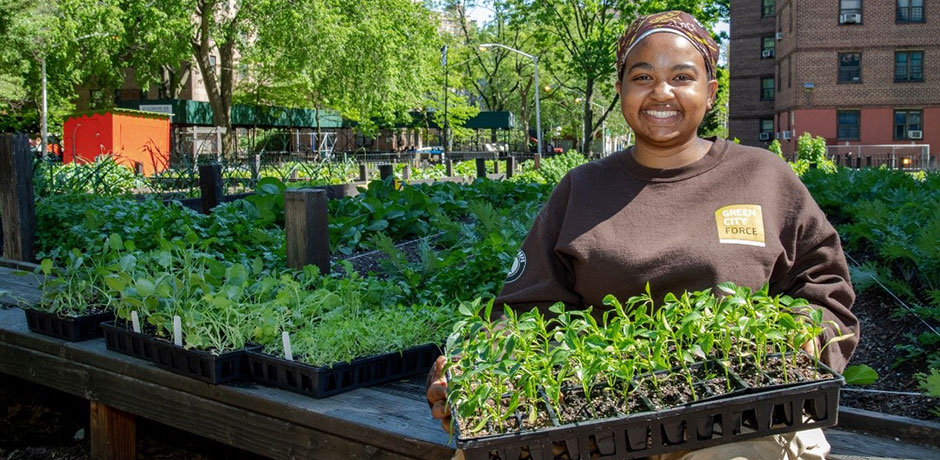Getting The City Blooming To Work
Getting The City Blooming To Work
Blog Article
All About City Blooming
Table of ContentsThe 4-Minute Rule for City BloomingCity Blooming for BeginnersCity Blooming for DummiesAbout City BloomingGetting The City Blooming To Work
Fascinated in expanding food for sale in the City of Chicago? Below is a checklist of often asked inquiries relating to the guidelines and policies that cultivators must think about when intending a metropolitan farming project.
The zoning change does not change any kind of other codes managing composting, structure permits, acquiring or leasing City owned residential or commercial property, business licenses or ecological contamination. There are existing codes that control these issues and they remain in complete effect and might apply to your job. Neighborhood gardens are commonly owned or managed by public entities, civic companies or community-based organizations and maintained by volunteers.
Urban farms grow food that is planned to be marketed, either on a not-for-profit or for-profit basis. Due to their commercial objective, urban ranches need a company permit.
City Blooming Can Be Fun For Everyone
The quantity of compost product can not go beyond 25 cubic lawns at any kind of offered time according to the criteria in 7-28-715 of the City's Municipal Code. Since the soil at the majority of brand-new garden sites needs amending, compost, dirt, timber chips, or various other products can be gotten to create or enhance the growing area.

If a building authorization is needed after that the hoophouse will certainly be thought about an accessory structure. You can discover out even more concerning the structure license requirements by speaking to the Department of Buildings. The 25,000-square-foot dimension restriction is meant to prevent a single neighborhood garden from dominating a given block or interfering with the block's existing residential or industrial personality.
The limit does not relate to gardens found in Public Open Space (POS) areas. Can there be more than one community garden that is 25,000 square feet on a solitary block? Yes. The size limitation puts on individual gardens, not to individual blocks. No. Secure fencing is not called for, nevertheless, yards that have big car parking locations may be required to set up secure fencing or other landscaping features.
The Only Guide to City Blooming
B1 & B2 districts need that all commercial use activities be carried out inside. R districts limit commercial task. The guidelines mirror the function and intent of the Zoning Code. Is fencing required for city farms? Yes. Fences might be needed, together with landscaping and testing, for sure car parking locations and outside job or storage space areas depending upon place and the specific activity taking place.
Urban ranches need building authorizations and zoning authorizations prior to building and construction (sustainability). Other forms of city testimonial might be required depending on certain structures, tasks, size, landscape design, licensing, public heath and stormwater monitoring issues.
Yes. The kind of license is determined by what is taking place at the site. The Department of Organization Affairs and Customer Security can assist establish the certain kind of organization certificate that's required. Yes. Off street vehicle parking is required for the majority of commercial jobs in Chicago. The needed variety of garage is based on the variety of workers servicing site and not the square footage of the expanding space.
The Definitive Guide to City Blooming

A metropolitan ranch can market compost product generated on website, nonetheless, the procedure has to conform with the laws in 7-28-715 of the Chicago Municipal Code. Aquaponic systems are allowed indoors on city farms in many zoning districts.
As much as five hives or swarms of honey bees may be kept as an accessory use. Beekeepers should register with the Illinois Division of Agriculture. To learn more concerning the suggested zoning modification you may get in touch with the Division of Housing and Economic Advancement, Bureau of Planning and Zoning at 312.744.8563.
Farming in cities and city locations A metropolitan farm in Chicago. Urban agriculture describes various techniques of cultivating. https://www.ted.com/profiles/47172561, processing, and distributing food in metropolitan areas. More about the author The term also puts on the location activities of pet husbandry, aquaculture, beekeeping, and horticulture in a metropolitan context. Urban farming is identified from peri-urban agriculture, which happens in backwoods at the side of residential areas.
10 Easy Facts About City Blooming Described
, that look for to form social networks established on a shared values of nature and area holism. These networks can establish by method of formal institutional assistance, coming to be incorporated right into regional town preparation as a "change town" activity for sustainable city advancement.
In either situation, the a lot more direct access to fresh vegetable, fruit, and meat items that may be understood through city agriculture can boost food security and food security while reducing food miles, causing reduced greenhouse gas exhausts, consequently adding to environment modification mitigation. Some of the first evidence of metropolitan agriculture originates from Mesopotamia.
Report this page